Ticket to Ride
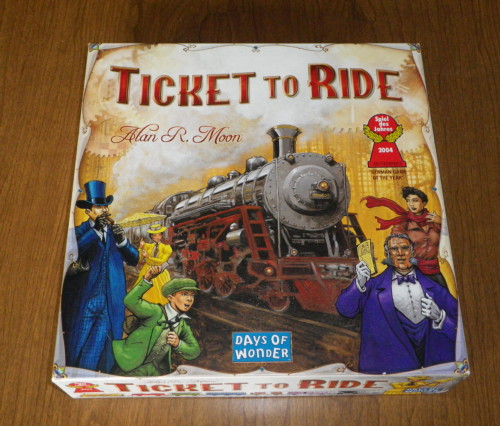
How about a nice game of Ticket to Ride?
What is it?: Ticket to Ride is a board game by Days of Wonder designed by Alan R. Moon wherein players try to earn the most points by completing train routes.
On a scale from Preschool to Post-Doc, how hard is it to play?: The official rules state “ages 8 and above” and that seems like a good range. Ticket to Ride is a game that takes some time to play and involves some strategy so take this into account if you think maybe your 7 year old or younger might want to play.
What will it cost me?: Days of Wonder sells Ticket to Ride for $50.00. They also sell the variations: Europe, Germany, Nordic Countries (all list at $50.00), Asia, and India (list at $30.00) plus two expansion packs for $20.00: TtR USA 1910 and TtR Europa 1912. Amazon is currently running a Ticket to Ride special for $37.00 and a place called Cool Stuff Inc will let you walk out their metaphorical doors with a copy for $30.00.
How many can play?: Officially “from 2 – 5 players”. There are only 5 sets of train pieces so 5 is your absolute max (unless you find a sixth set of train pieces or jury rig a sixth set of train pieces). On the other hand, the two player game is not as cutthroat as some other games where there is much more direct competition.
How long does it take to play?: The rules say “30 – 60 minutes” and that seems about right with 45-50 minutes being a good average.
What do I need to play?: Ticket to Ride.
How do I play it?: The official rules can be found all neatly tucked onto a pdf here but as long as you are reading, I’ll explain the general gist of the game.
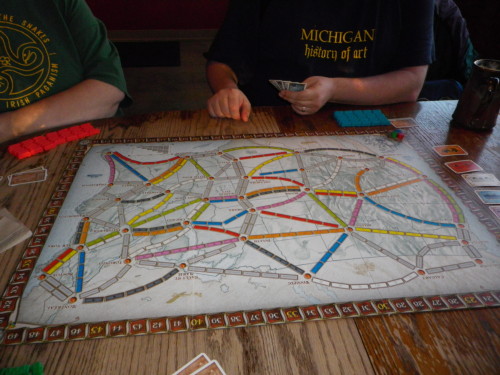
Set-up: (Apologies for the upside-down U.S.) Everyone starts out with a pile of 45 colored train pieces (black, red, blue, green, or yellow) and a scoring marker in the same color. The scoring markers should be placed on the “Start” square located on the numbered track around the board and will be advanced to the appropriate number as the game progresses and points are accumulated.
Deal out 4 Train Car cards and three Destination cards to every player. Lay out 5 Train Car cards face up along one side of the board and place the rest of the deck face down at one end of the 5 cards. Place the Destination Ticket cards deck face down somewhere nearby.
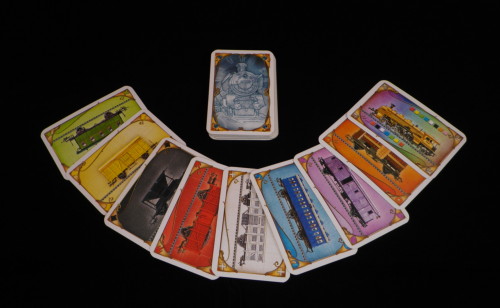
The Train Car cards are your hand, keep them hidden.
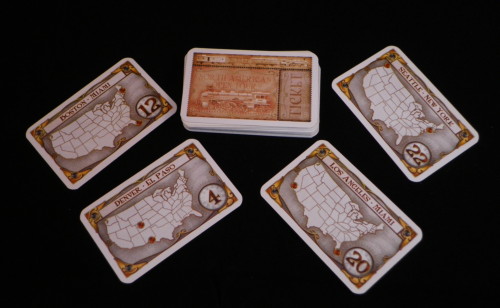
The Destination Ticket cards are your goal(s), keep them hidden as well.
Before actual play begins, each player looks at their Destination Ticket cards and decides which ones they will attempt to complete. You are allowed to discard one of the three Destination Ticket cards if you choose, or you can attempt to complete all three. Decide who goes first by determining who is the most experienced traveler in the group. Play proceeds clockwise thereafter.
Start of Play: On your turn you can either:
1. Draw 2 Train Car cards from either the line of 5 face up cards (the “specific draw pile” as it were, considering that you know exactly what color train card you are drawing) or randomly from the face down deck or mix and match piles. If you draw from the “specific draw pile” replace that card with the top card from the random draw pile.
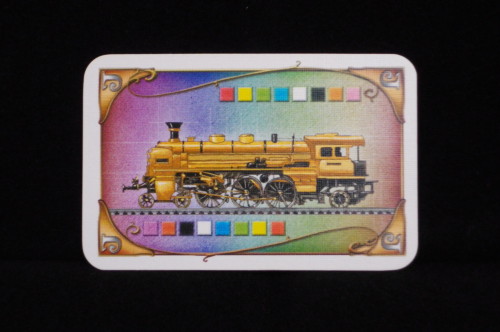
Locomotive cards count as a two card draw from the “specific draw pile” so if you choose a Locomotive card from that pile it counts as your two draws. Conversely, if you have already drawn a Train Car card from the “specific draw pile” you can not then draw a Locomotive card. There is no restriction to how many Locomotive cards you can draw if you choose to draw from the “random draw” pile (other than two since you can only draw two cards). If at any point three Locomotive cards are face up in the “specific draw pile”, discard all the cards from the “specific draw pile” and repopulate with five new face up cards from the random draw pile. This can happen between a player’s first and second draw.
If at any time the “random draw” pile is exhausted, shuffle the discards pile and place them face down for a new “random draw” pile.
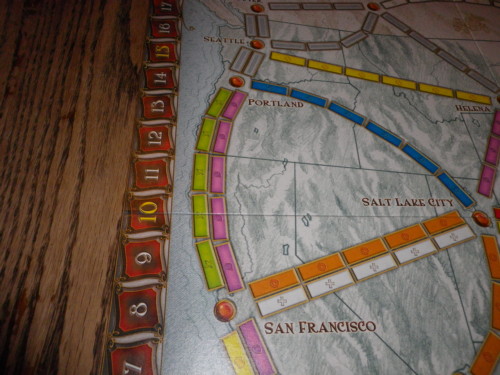
2. Claim a Route by placing your train pieces along the section of track you wish to claim. Routes are defined as single stretches of track that join up two cities. In order to claim a Route, you have to have the appropriate number of colored Train Car cards for that track. For instance to get from Portland to Salt Lake City, I’ll need six blue Train Car cards as there are six blue sections of track. Locomotives count as wild cards so if I only have five blue Train Car cards and one Locomotive card I can claim the Route as well. Train Car cards and Routes come in Purple, White, Blue, Yellow, Orange, Black Red and Green.
Some Routes, like Portland to San Francisco, have two sets of track that run parallel to each other from city to city (a five section of purple and a five section of green). One player can not monopolize both Routes to the same destination and in the two and three player games only one of the two Routes can be claimed.
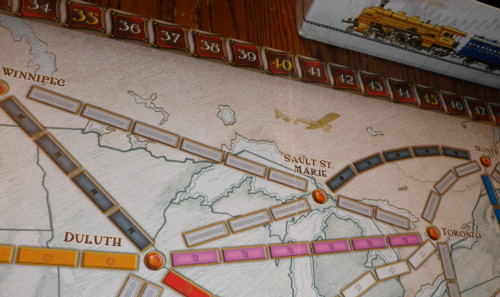
Some Routes are also marked in Gray which means that any one continuous run of color Train Car cards (including any Locomotive Cards) will fulfill the requirement for claiming the Route. In order to get from Sault Ste. Marie to Winnipeg, I will need six of any like colored Train Car card (or a mix of like color Train Car cards and Locomotive cards).
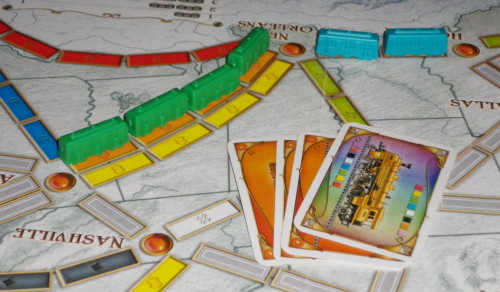
I have decided to claim Atlanta to New Orleans with 3 orange and one locomotive Train Card.
It is a good idea to claim Routes along the tracks which fulfill your Destination Ticket cards but you don’t have to claim Routes in a continuous straight line if you don’t want to.
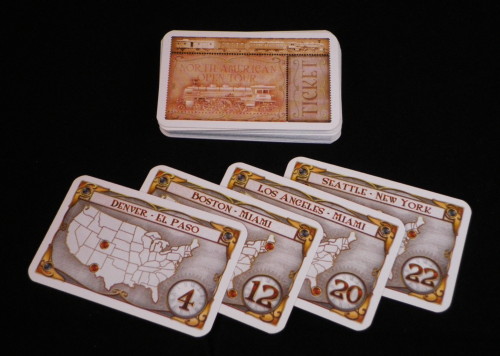
3. Draw Destination Tickets. You may pick new Destination Tickets by drawing three Destination Ticket cards and keeping at least one of them. You may keep two or all three if you wish, but any Destination Tickets which are not completed by the end of the game are subtracted from your overall score. Once you have decided on which Destination Tickets you want to keep, place the unwanted Destination Ticket cards at the bottom of the Destination Ticket card draw pile.
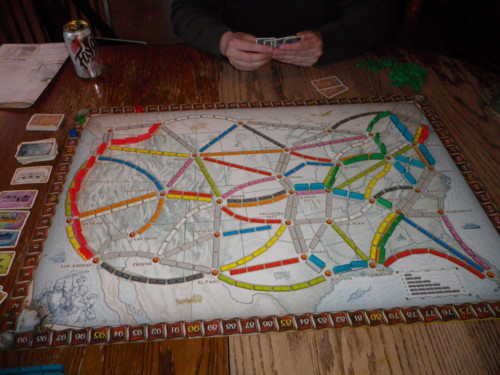
Dort, Matt and I in media res.
Endgame criteria: When any player has used all but two (or one or zero, depending on how Routes are claimed) of their train pieces, the end game is triggered. All players get one more turn after that and then scores are tallied.
Scoring: Throughout the game, players get points for claiming Routes.
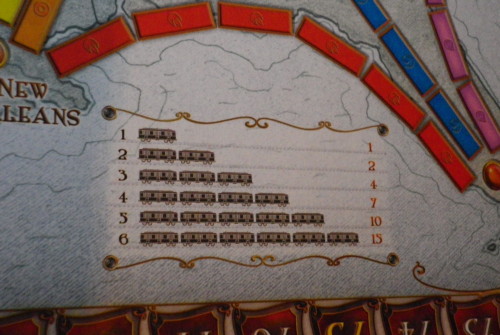
The scoring matrix for claiming Routes is printed on the board so every time you claim a Route, be sure to advance your scoring token that many spaces on the numbered ring around the edge of the board.
After the end game is triggered and everyone has taken their one last turn, all the completed Destination Tickets are added and the incomplete Tickets are subtracted (Destination Ticket points are printed in the corner of the ticket – for instance in the first Destination Ticket picture above, Denver to El Paso will earn you 4 points). The total points from Destination Tickets are added to the score acquired during game play. Lastly, 10 points are given for the player who completed the Longest Continuous Path of Routes. Whoever has the most points wins. In case of a tie, the player with the most completed Destination Tickets wins.
Would you recommend this game?: I absolutely would. I have a friend who is the super regional solar system champion of train stuff (or something close to that anyhow) so I asked her one day, “What was up with this Train Game thing?” As it turns out, there are several train games, but Ticket to Ride seems to be one of the easiest ones to play. So I went and signed up to play Ticket to Ride (I was at a convention at the time) figuring I’d learn how to play and things would be peachy. Little did I realize that I accidentally signed up for the Ticket to Ride tournament and no amount of weaseling or pleading utter blithering n00biness would get me out of the tourney. The train game peeps simply sat me down and we played for a quick 15 minutes before the tournament began and then they tossed me into the deep end. It was AWESOME! Seriously, I did not lose my first game by a bajillionty points which is what I was expecting. Instead, it was a really tight game and it came down to who had the longest continuous path of routes to determine a winner.
Ticket to Ride combines strategy, luck and ease of play really nicely. Heck, you can be tournament ready in just 15 minutes from having never even seen the game (OK, I confess that my tournament mates were about the same level of competent as I was but still…the mechanics are pretty simple). I’m not sure I’d enjoy playing with my friend, the regional awesome train maestro because I expect she’d skunk me every single time and there IS no mechanism for skunking in Ticket. However playing with players at my neophyte level of skill would be fun and entertaining.
EXTRA ADDED ELECTRONIC BONUS
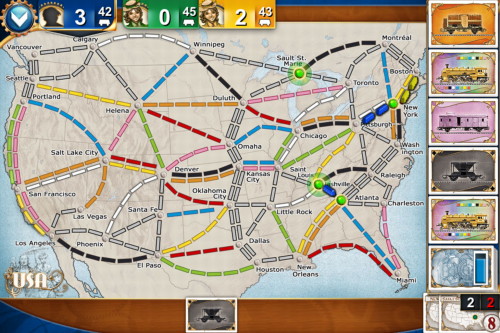
(iPhone Version)
Even better (and cheaper) than the board game, but not as socially entertaining, you can purchase Ticket to Ride for the IPhone or iPad (we have both). It’s a $1.99 purchase through iTunes and I have to say that I might be addicted to this app. Unlike the full board game, the app is very portable and awesome for getting in a little train game action on the go. The Ticket to Ride app also takes considerably less time to play; perhaps 10 minutes a game if you are playing solo. There is a “Pass and Play” option as well but that takes a wee bit longer.
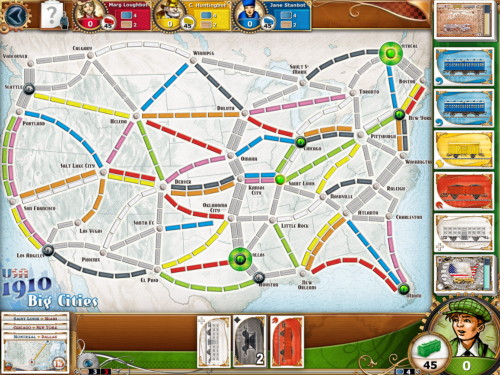
(iPad version)
The other advantage to the app is that it will highlight your end cities on any Destination Ticket if you ask it to. If only my eyes could do this in the real game I’d be set (and also maybe a touch spooky). The down sides are that the AI players aren’t all that clever (actually, at my level of play I find that a perk) and it’s a bit difficult to see immediately how many train pieces are left on any given player, including yourself. The iPad and iPhone games are laid out slightly differently so some of that confusion might be switching platforms but I think it’s still easier to look at a pile of train pieces than to remember which number represents trains on the AI portraits (and which is your own number).
Possibly the best path is to purchase the app and then become addicted to the game such that $50 doesn’t seem that big a commitment for all the fun and entertainment Ticket to Ride gives.
-JQuirk
Register for the convention and sign up for Ticket To Ride events.


It wasn’t mentioned, but the India/Switzerland and Asia expansions, and the 1910 and 1912 expansions require a copy of either TtR USA, Europe, or Marklin to play. Also, Ticket to Ride Africa comes out this December! 😀
Switzerland and Nordic Countries are 2 to 3 players only, India is 2 to 4 players, and Asia is 2 to 5 players (I think) for legendary Asia and 2,4, or 6 players for Team Asia.